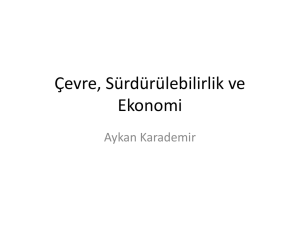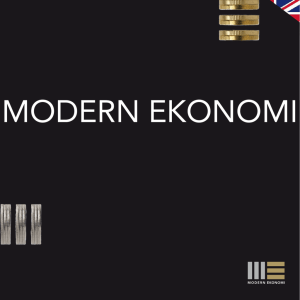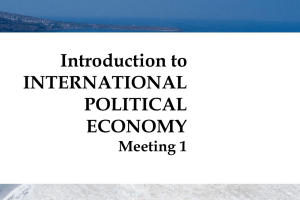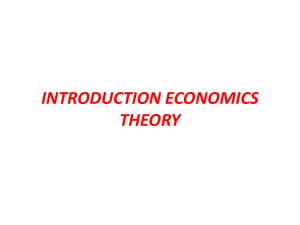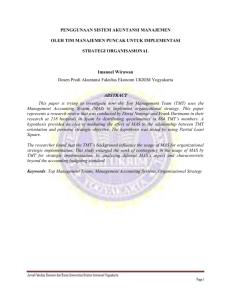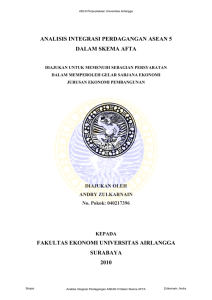Ruang Lingkup Makro Ekonomi
advertisement
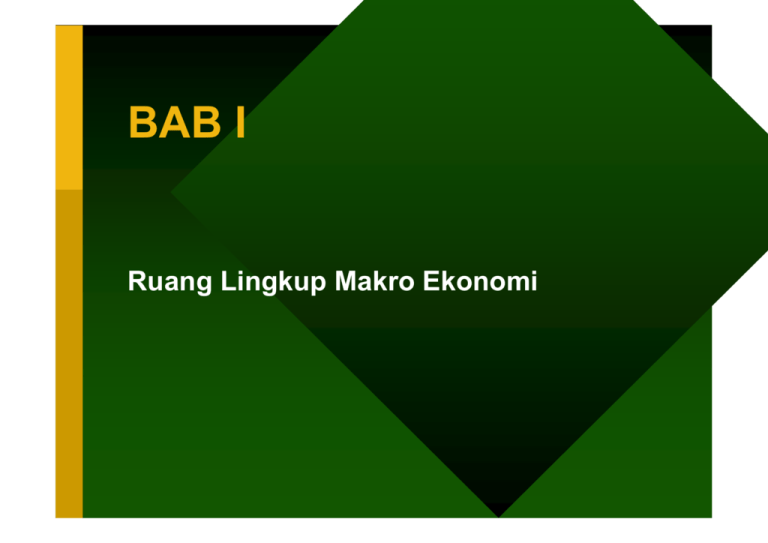
BAB I Ruang Lingkup Makro Ekonomi A. PENGERTIAN TEORI EKONOMI MAKRO • Ialah bagian dari Ilmu Sosial, bidang yg dipelajari sangat luas (tapi terbatas). • Luas dalam arti meliputi tingkah laku manusia dalam usaha untuk memenuhi kebutuhan dengan segala yang berhubungan dengan hal tersebut. • Ekonomi Makro adalah : Bagian dari ilmu ekonomi yang mempelajari satuan-satuan pengambilan keputusan secara keseluruhan/agregat. Untuk mempelajari Ilmu Ekonomi diperlukan suatu metode yang disebut dengan Metode Ilmu. Ada tiga tahap dalam metode ilmu: • Melihat Kenyataan. • Menjelaskan (menunjukkan hubungan), ada 2 jenis hubungan : a. hubungan kausal (sebab akibat) fungsi matematis b. hubungan fungsional kesamaan matematis • Mengetrapkan. Ada tiga pembagian analisa ekonomi, yaitu : • Ekonomi Deskriptif • Teori Ekonomi • Ekonomi Terapan B. Ekonomi Normatif dan Positif • Ilmu Ekonomi Positif: membahas ttg apa dan bagaimana senyatanya masalah-masalah ekonomi dipecahkan. • Menjelaskan fakta-fakta ekonomi • Menjelaskan: apa yg terjadi; apa yg akan terjadi; apa implikasi kebijakan pemerintah Misal: Inflasi akan lebih dari 10%; pengangguran akan meningkat; Jika pajak meningkat, konsumsi akan turun Ilmu Ekonomi Normatif Mempelajari ttg apa yg seharusnya terjadi, atau bgmn seharusnya masalah ek rakyat dipecahkan Menyangkut masalah etika dan nilai Misal: pemerataan hrs ditingkatkan; Pemerintah hrs menurunkan inflasi; kebijakan pemerintah hrs memperkecil pengangguran C. TUJUAN KEBIJAKAN EKONOMI MAKRO • Kebijakan Ekonomi Makro adalah : Tindakan pemerintah dalam usaha untuk mempengaruhi jalannya perekonomian melalui variable-variabel agregatif untuk mencapai tujuan yang diharapkan. There are three kinds of policy that the government has used to influence the macroeconomy: 1. Fiscal policy 2. Monetary policy 3. Growth or supply-side policies Government in the Macroeconomy • Fiscal policy refers to government policies concerning taxes and expenditures. • Monetary policy consists of tools used by the Federal Reserve to control the money supply. • Growth policies are government policies that focus on stimulating aggregate supply instead of aggregate demand. Macroeconomics D. The Roots of Macroeconomics • The Great Depression was a period of severe economic contraction and high unemployment that began in 1929 and continued throughout the 1930s. The Roots of Macroeconomics • Classical economists applied microeconomic models, or “market clearing” models, to economy-wide problems. • The failure of simple classical models to explain the prolonged existence of high unemployment during the Great Depression provided the impetus for the development of macroeconomics. E. Recent Macroeconomic History • In 1936, John Maynard Keynes published The General Theory of Employment, Interest, and Money. • Keynes believed governments could intervene in the economy and affect the level of output and employment. • Fine-tuning was the phrase used by Walter Heller to refer to the government’s role in regulating inflation and unemployment. F. Macroeconomic Concerns • Three of the major concerns of macroeconomics are: –Inflation –Output growth –Unemployment Inflation • Inflation is an increase in the overall price level. • Hyperinflation is a period of very rapid increases in the overall price level. Hyperinflations are rare, but have been used to study the costs and consequences of even moderate inflation. Output Growth • The business cycle is the cycle of shortterm ups and downs in the economy. • The main measure of how an economy is doing is aggregate output: – Aggregate output is the total quantity of goods and services produced in an economy in a given period. Output Growth • A recession is a period during which aggregate output declines. Two consecutive quarters of decrease in output signal a recession. • A prolonged and deep recession becomes a depression. • The size of the growth rate of output over a long period is also a concern of macroeconomists and policy makers. Unemployment • The unemployment rate is the percentage of the labor force that is unemployed. • The unemployment rate is a key indicator of the economy’s health. • The existence of unemployment seems to imply that the aggregate labor market is not in equilibrium. Why do labor markets not clear when other markets do? G. The Components of the Macroeconomy • Everyone’s expenditures go somewhere. Every transaction must have two sides. H. The Three Market Arenas • Households, firms, the government, and the rest of the world all interact in the goodsand-services, labor, and money markets. The Three Market Arenas • Households and the government purchase goods and services (demand) from firms in the goods-and services market, and firms supply to the goods and services market. • In the labor market, firms and government purchase (demand) labor from households (supply). – The total supply of labor in the economy depends on the sum of decisions made by households. The Three Market Arenas • In the money market—sometimes called the financial market—households purchase stocks and bonds from firms. • Households supply funds to this market in the expectation of earning income, and also demand (borrow) funds from this market. • Firms, government, and the rest of the world also engage in borrowing and lending, coordinated by financial institutions.

